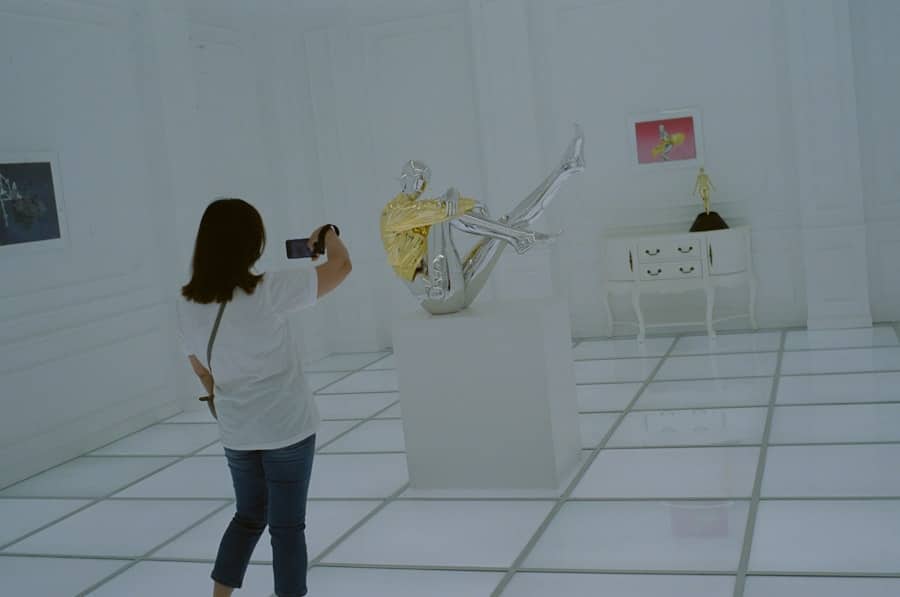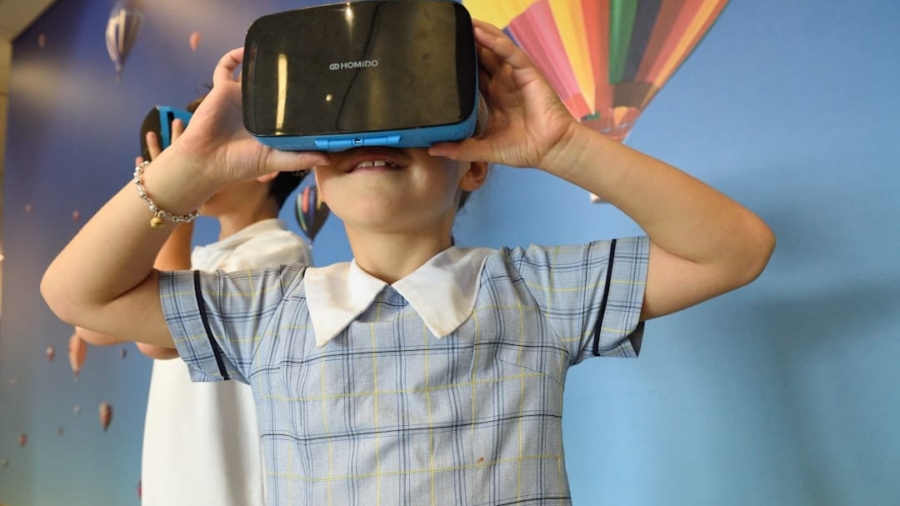Augmented Reality (AR) has emerged as a transformative technology in various fields, and its application in education, particularly in history, is gaining traction. By overlaying digital information onto the physical world, AR creates immersive experiences that can enhance learning and retention. In history education, where context and visualization are crucial for understanding complex events and timelines, AR offers a unique opportunity to engage students in ways that traditional methods cannot.
The integration of AR into history curricula allows educators to present historical narratives dynamically, making the past more accessible and relatable to students. The potential of AR in history education lies not only in its ability to present information but also in its capacity to foster critical thinking and inquiry-based learning. Students can interact with historical artifacts, explore significant events, and even engage with virtual representations of historical figures.
This interactive approach encourages learners to ask questions, draw connections, and develop a deeper understanding of historical contexts. As educators seek innovative ways to captivate the attention of a generation raised on technology, AR stands out as a promising tool that can bridge the gap between the past and present.
Key Takeaways
- AR in history education enhances student engagement and interaction with historical content.
- AR applications in history education bring historical events to life, making them more immersive and memorable for students.
- AR helps students visualize and understand historical events and places, making learning more interactive and impactful.
- Using AR in history education can overcome challenges such as lack of access to historical sites and artifacts, and limited resources for hands-on learning.
- The future of AR in history education holds potential for further innovation and transformation in the way students learn and engage with history.
The Impact of AR on Student Engagement
One of the most significant impacts of AR in history education is its ability to enhance student engagement. Traditional teaching methods often rely on lectures, textbooks, and static images, which can lead to passive learning experiences. In contrast, AR transforms the learning environment by allowing students to actively participate in their education.
This active participation fosters a sense of ownership over their learning process. Moreover, AR can cater to various learning styles, making history more inclusive.
Visual learners benefit from seeing 3D models of ancient artifacts or reconstructions of historical sites, while kinesthetic learners engage through interactive simulations. Auditory learners can access narratives or discussions embedded within the AR experience. By accommodating diverse learning preferences, AR not only increases engagement but also promotes a more comprehensive understanding of historical content.
The excitement generated by these immersive experiences can lead to increased motivation and curiosity about history, encouraging students to explore beyond the classroom.
Examples of AR Applications in History Education

Several innovative AR applications have been developed specifically for history education, showcasing the technology’s versatility and effectiveness. One notable example is the “Civilizations AR” app created by the British Museum. This application allows users to explore artifacts from various cultures and time periods in 3D.
Students can examine objects like ancient Egyptian mummies or Greek vases up close, gaining insights into their historical significance. The app also provides contextual information and narratives that enrich the learning experience, making it an invaluable resource for educators. Another compelling example is “Google Expeditions,” which offers virtual field trips that incorporate AR elements.
Educators can take students on immersive journeys through historical sites such as the ruins of Pompeii or the Great Wall of China. By using smartphones or tablets, students can view these locations from different angles and perspectives, enhancing their understanding of geography and history simultaneously. Such applications not only make history more tangible but also encourage collaborative learning as students share their discoveries with peers during these virtual expeditions.
The Role of AR in Making Historical Events Come Alive
AR plays a crucial role in bringing historical events to life by providing context and depth that traditional methods often lack. For instance, during a lesson on World War II, an AR application could allow students to visualize key battles or significant moments through interactive simulations. They could witness the D-Day landings from multiple perspectives or explore the strategic decisions made by military leaders in real-time.
This immersive experience helps students grasp the complexities of historical events and understand their implications on contemporary society. Furthermore, AR can facilitate emotional connections to history by allowing students to engage with personal stories from individuals who lived through significant events. Applications like “HistoryView” enable users to interact with holographic representations of historical figures who share their experiences and perspectives.
This personal touch humanizes history, making it relatable and impactful for students. By stepping into the shoes of those who experienced pivotal moments firsthand, learners can develop empathy and a deeper appreciation for the struggles and triumphs of past generations.
The Benefits of Using AR in History Education
The benefits of incorporating AR into history education extend beyond mere engagement; they also encompass enhanced retention and comprehension of material. Research has shown that interactive learning experiences lead to better information retention compared to traditional methods. When students actively participate in their learning through AR, they are more likely to remember key concepts and details about historical events.
This retention is crucial in history education, where understanding timelines and connections between events is essential for building a coherent narrative. Additionally, AR promotes collaborative learning among students. Many AR applications are designed for group activities, encouraging teamwork as students work together to solve problems or complete tasks related to historical content.
This collaborative approach not only enhances social skills but also fosters critical thinking as students discuss their findings and perspectives with one another. The ability to share insights and challenge each other’s viewpoints creates a dynamic learning environment that enriches the educational experience.
Overcoming Challenges in Implementing AR in History Education

Despite its numerous advantages, implementing AR in history education is not without challenges. One significant hurdle is the accessibility of technology. Not all schools have the necessary resources or infrastructure to support AR applications effectively.
Educators may face limitations regarding devices, internet connectivity, or technical support, which can hinder the integration of AR into their curricula. To address this issue, schools must prioritize investment in technology and provide training for teachers to ensure they are equipped to utilize these tools effectively. Another challenge lies in curriculum alignment.
Educators must ensure that AR applications complement existing lesson plans and educational standards rather than serve as standalone activities. This requires careful planning and collaboration among educators to identify appropriate applications that align with learning objectives. Additionally, teachers must be prepared to adapt their instructional strategies to incorporate AR seamlessly into their teaching practices.
Professional development opportunities focused on integrating technology into pedagogy can help educators navigate these challenges and maximize the benefits of AR in history education.
The Future of AR in History Education
The future of AR in history education holds immense potential as technology continues to evolve. As AR hardware becomes more affordable and accessible, we can expect wider adoption in classrooms around the world. Innovations such as wearable devices like smart glasses may further enhance the immersive experience by allowing students to interact with their environment without being tethered to screens.
This hands-free approach could revolutionize how students engage with historical content, enabling them to explore their surroundings while accessing digital information seamlessly. Moreover, advancements in artificial intelligence (AI) could lead to more personalized learning experiences through AR applications. AI algorithms could analyze individual student performance and preferences, tailoring content delivery to meet specific needs.
For instance, if a student struggles with understanding certain historical concepts, an AI-driven AR application could provide additional resources or alternative explanations tailored to their learning style. This level of personalization could significantly enhance student outcomes and foster a lifelong love for history.
The Potential of AR to Transform History Education
The integration of Augmented Reality into history education presents an exciting opportunity to transform how students learn about the past. By enhancing engagement, fostering collaboration, and providing immersive experiences that bring historical events to life, AR has the potential to revolutionize traditional teaching methods. While challenges remain in terms of accessibility and curriculum alignment, ongoing advancements in technology promise a future where AR becomes an integral part of history education.
As educators continue to explore innovative ways to captivate students’ imaginations and deepen their understanding of history, AR stands out as a powerful tool that can bridge the gap between past and present. By embracing this technology, we can inspire a new generation of learners who are not only knowledgeable about history but also passionate about exploring its complexities and relevance in today’s world.
A related article to “How AR Is Making History Education Immersive and Interactive” discusses the return of Instagram’s founders to the social media scene. The article explores what we can learn from their comeback and how it may impact the future of social media platforms. To read more about this intriguing topic, check out this article.
FAQs
What is AR?
AR stands for Augmented Reality, which is a technology that superimposes digital information such as images, videos, or 3D models onto the real world, typically viewed through a smartphone or a special headset.
How is AR being used in history education?
AR is being used in history education to create immersive and interactive experiences for students. It allows them to visualize historical events, explore ancient artifacts, and interact with historical figures in a way that traditional textbooks cannot provide.
What are the benefits of using AR in history education?
Using AR in history education can make learning more engaging and memorable for students. It allows them to experience history in a more interactive and immersive way, which can help improve their understanding and retention of historical information.
What are some examples of AR applications in history education?
Some examples of AR applications in history education include virtual tours of historical sites, interactive timelines of historical events, and AR-enhanced textbooks that bring historical figures and artifacts to life.
Is AR accessible to all students?
While AR technology is becoming more accessible, not all students may have access to the necessary devices or resources to fully utilize AR in their history education. However, as the technology continues to develop, it is likely to become more widely available in educational settings.

